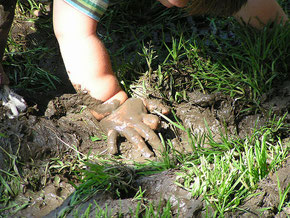DIY lawn and garden drainage guide
Drainage services Aerating Lawn Working with Clay Garden drainage Systems Drainage shop Sumps and pumps
I have an opportunity for a self employed garden drainage specialist to take on leads information
Information on this page
- How to install garden drainage. D.I.Y.
- Materials you will need.
- DIY Information sheet.
- Testing a waterlogged garden.
- What are the main reasons for waterlogged garden problems?
- How can I drain water away and fix a waterlogged garden and soggy lawn problem myself ?
- Tools needed to install garden drainage and dig the trenches.
- Using prefabricated soakaway drainage baskets and crates.
Follow this link to;
Or ask Mike about our

Can I fix a waterlogged garden problem myself?
- Yes you can drain and dry out a muddy, soggy waterlogged garden even on clay soil by installing the French drain system described here.
- So if your fed up with the mud follow the tips on this page and the guide featured below and you really can do it yourself.
How do I know if my garden is waterlogged

What causes garden drainage problems?
Common causes of a waterlogged garden
- Heavy sustained rainfall can cause underground springs to change direction.
- Compacted soil combined with the mixing of subsoil and topsoil when the house was built is a very common reason for soggy spongy lawns.
- Clay soil. You can't blame it all on the builder, it's more likely the house and garden have been built on clay (easily recognised because the surface cracks up when it is dry). Not easily avoidable however, as great swathes of the UK consist of clay soil.
- The garden is lower than neighbouring gardens or at the bottom of a hill. Water flows downwards and unless it has been dealt with upstream by installing a drainage system to catch or divert the water, is naturally going to be a problem downstream. It's not really your neighbour's fault that this is happening.
- Structures like swimming pools, home extensions you or neighbours have added can all cause gardens to flood. Anything with deep footings can divert water.
- Uneven lawn or garden surfaces. On clay and other water retentive soils, the flow of water through the soil is very slow made worse by dips in the surface allowing water to puddle and flood during heavy rain.
- Hard landscaping. The increasing use of impermeable materials to construct car parking, driveway and patios is a problem. Rainwater that should be soaking into the ground runs across the hard impermeable surface into the property and gardens below it. If you are unlucky enough to live next to (and lower than) a tarmac or concrete parking area, you could try asking the culprit to install a French drain on their side to catch and divert the water away from your property.
- Is it the Water Table? Some water table information here.
- Gutters and down-pipes not connected into the drainage system (or blocked) instead discharging onto the garden or patio. Always connect the down-pipe into a drain.
- Neighbour diverting water into your property. If your neighbour has recently installed a garden drainage system, check to see if it's terminating at the boundary between your properties and discharging water into your garden.
A lot of time and money can be spent trying to trace the water source, leading to disputes with neighbours, the surveyor and builder who built the extension, the landscape gardener who installed your paving and retaining wall without considering the effect on soil drainage.
How to install DIY garden drainage.
Solution? for most waterlogged garden problems the only solution is to drain the water away.
Mikes easy to follow Garden and lawn drainage D.I.Y. guide
Drawing on years of experience this easy to follow basic guide shows how to Install French drains.
- Marking out and digging trenches
- Finding lowest spot for positioning the Soak away.
- Materials and Quantities (how much gravel) to form the drains.
- 5 mins free Telephone back-up
- Simple easy to follow steps
- Terms

PDF normally Emailed within the hour or 8 hours if i'm out of the office

£10.00. Converted to $ and € or local currency outside the U.K
Happy user
Just completed the drainage on my lawn using your diy guide, must say it was simple to follow still hard work, but what a difference, my boys can play on the lawn again, and I did save a lot of money. I found the gravel calculator really useful, ended up with a bit left over but probably my calculation.
Thanks again and for the chat on the phone (well worth a tenner)
Jason. Leeds
name and address supplied
Herringbone drainage
Herringbone drainage works for both, lawns and gardens that are waterlogged over the whole area or part just an area, this is normally the lowest part of the garden.
- Mark out the main trench from the highest part of the lawn, to the lowest.
- Mark the side trenches to connect to the main drain, forming a herringbone pattern. The side drains join the main drain at a 45 degree angle.
- Space side drains at 10 ft intervals for clay soil and 25 ft intervals for loamy soil
- Dig out the trenches to at least 18 inches deep, saving about 6" off the best clay free topsoil to backfill.
- Line the trench with landscape fabric to keep earth out of the gravel to allow water to percolate through easily.
- Shovel coarse 20 ml gravel onto the landscape fabric leaving the top 4 to 5 inches to back fill with saved soil, fold the fabric over the top of the gravel before backfilling.
- Shovel or rake the topsoil you have saved back into the trench, slightly over filling to allow for settling.
- At the lowest end of the main trench dig out a soak away at least 4 ft deep and link the main drain to the centre of the soak away. Bear in mind if you hit clay when digging out the soak away it's not going to drain and you will need to look at either connecting into the surface water drain system or installing a sump and pump
Single French drain.
Used to drain water away from a wet, soggy or waterlogged part of your garden to a soakaway or drain.
Slope the French drain to carry the water down to its destination. Dig the trench across the waterlogged area and towards the soak away. This type of drain need only be about 6" wide and 12" deep. Before filling with gravel, line the trench with landscape fabric to keep earth out of the gravel to allow water to percolate through easily. Shovel 5 to 7 inches of 20 ml coarse gravel onto the landscape fabric. Wrap the fabric over the top of the gravel and top up with soil.
Happy user
Just completed the drainage on my lawn using your diy guide, must say it was simple to follow still hard work, but what a difference, my boys can play on the lawn again, and I did save a lot of money. I found the gravel calculator really useful, ended up with a bit left over but probably my calculation.
Thanks again and for the chat on the phone (well worth a tenner)
Jason. Leeds
name and address supplied
Tools and materials to dig and make drainage trenches.
Tools you will need to dig drainage trenches.
Digging drainage trenches is a lot easier if you use the correct tools.
Strong rake, Drain spade, Trenching shovel, Digging Hoe.
Rake 1500 mm
Over the years I have broken more ordinary garden rakes raking clay than I care to remember. I have used this Heavy duty all steel rake for years and it is still being used by my team.
It is strong enough and suitable for raking and breaking up heavy clay soil.
Forged Trench Shovel, 970 mm
Heavy duty forged steel head Tubular steel shaft and MYD handle Heat treated for durability For digging and bottoming trenches Blade L x W: 270 x 165 mm
Forged Drain Spade, 1150 mm
Heavy duty forged steel head with extended shoulders for safer foot-grip. For digging drain and pipe channels, trenches and fence post holes.
Materials for garden drainage.
Woven fabric with securing pegs useful for holding the fabric in place when shovelling in the gravel. Lets rainwater through and is essential in keeping the soil out of the gravel.
20mm Gravel/Shingle (Bulk Bag) with free delivery in UK
This is the type and size of gravel you will need to fill the drainage channels.
As an alternative to using gravel consider the prefabricated crates below.
Pre fabricated soakaway and trench baskets
The pre-fabricated soakaway system offers an alternative to gravel when installing a French drain garden drainage system. Crates measures
800x500x540mm = 0.216m3 Volume
Sump pump information on my Sumps and Pumps page
Pre fabricated soakaway and trench baskets
The crates are wrapped in a special geotextile fabric which allows water to soak through into the crates, but keeps soil out. They can be used in exactly the same way as traditional gravel filled soakaways and trenches.
Dig out the hole or trench to the required length, width and depth, then place the wrapped crates into the soakaway hole or drainage channel. Connect any pipe work and back-fill with soil.
What won't work to drain and dry out a waterlogged garden
You can connect into the surface water drainage: this is the drainage system that deals with rainfall from your gutters etc. Some authorities will require you to seek permission.
Writing your first book or novel? This new website provides advice and tips to help write, edit, publish, market and promote it https://www.faircop.com/
